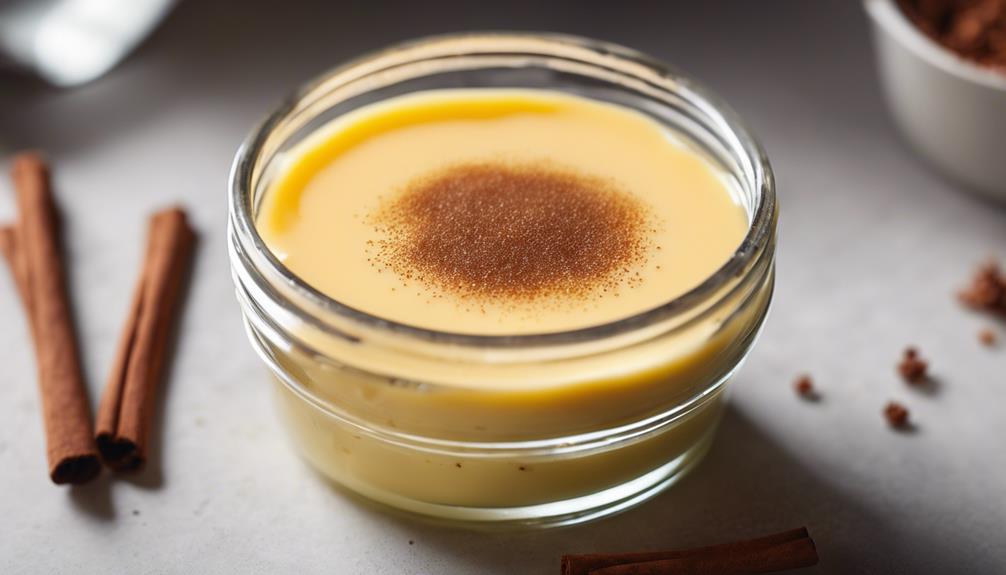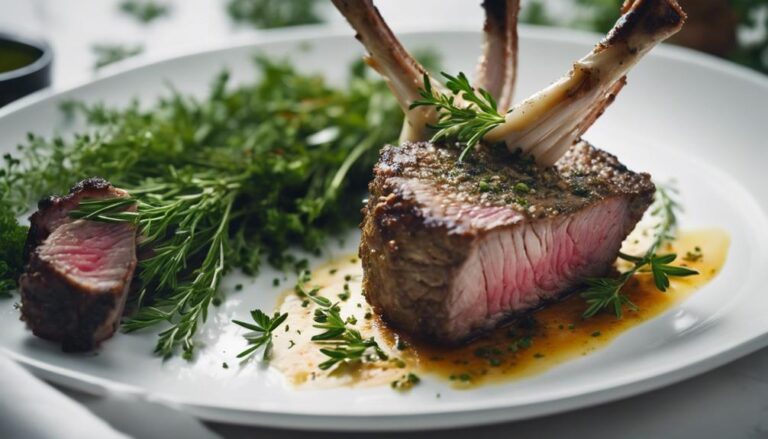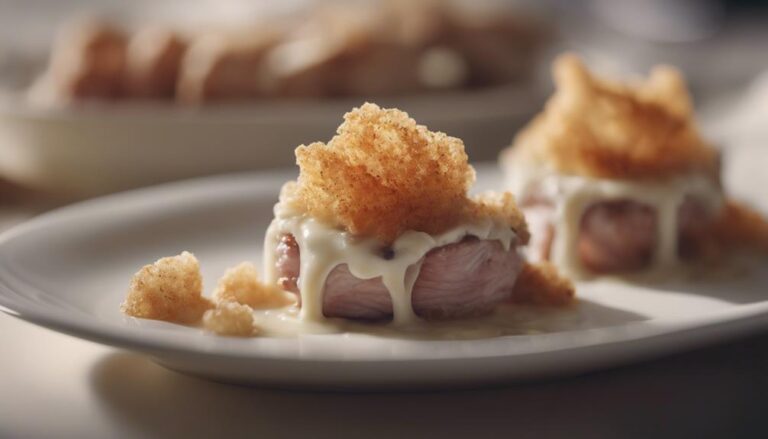Sous Vide Egg Custard: A Sweet Protein Treat
Satisfy your sweet tooth with a protein-rich twist—sous vide egg custard offers a velvety indulgence. Achieve a silky smooth texture through precise water bath cooking. Whip up a delightful treat blending sweetness and protein in every bite. Intrigued by the decadent blend of flavors and nutrients?
What You Will Learn Here
- Protein-rich dessert option
- Balanced sweetness for indulgence
- Precise sous vide method for creamy texture
- Elegant and comforting menu addition
- Appeals to those preferring less sugary treats
Egg Custard Evolution
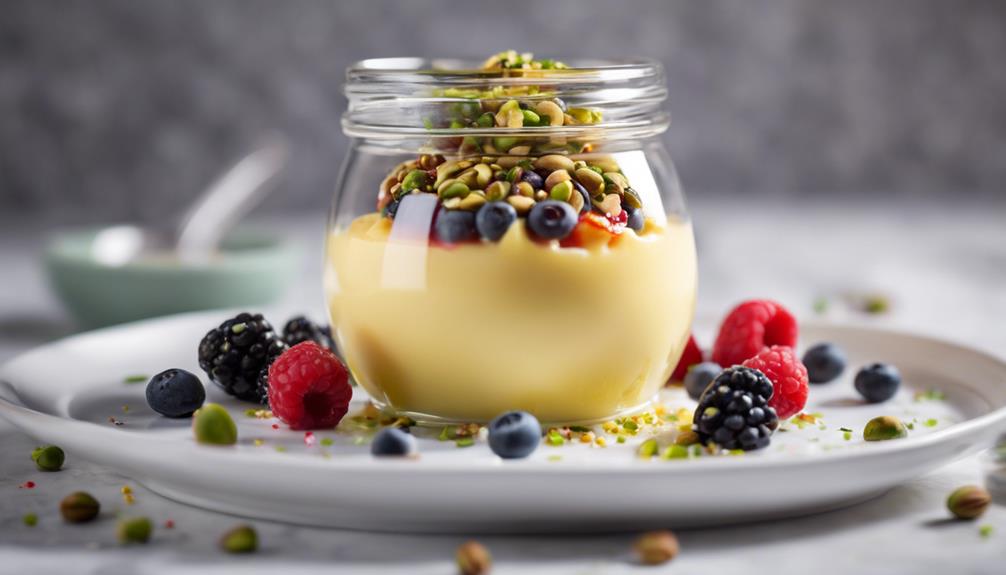
Explore the evolution of egg custard, tracing its historical roots, the diverse flavor profiles that have emerged, and the contrasting techniques between traditional baking methods and the modern sous vide approach.
Understand how custard has evolved over time, adapting to different culinary preferences and advancements in cooking technology.
Compare the nuances of custard preparation through history, highlighting the shifts in taste, texture, and the overall culinary experience.
History of Custard
Through centuries of culinary evolution, custard has transformed into a versatile and beloved dessert enjoyed across various cultures worldwide. The origins of custard date back to ancient Roman times, where it was a popular dish made with milk, eggs, and honey. Over time, custard became a staple in European cuisine, with variations like creme brulee and flan emerging. Its creamy texture and rich flavor have made it a favorite in both sweet and savory dishes.
| Custard Origins | Culinary Traditions |
|---|---|
| Ancient Rome | Popular dessert |
| Europe | Variations like creme brulee |
When it comes to health benefits, custard provides a good source of protein, calcium, and vitamins. Its nutritional value varies depending on the ingredients used, making it a versatile option for those seeking a balanced diet.
Flavor Variations
The evolution of egg custard has led to an array of flavor variations that cater to diverse palates and culinary preferences. Flavor pairing plays an essential role in enhancing the sensory experience of egg custard. Ingredients like vanilla, caramel, or fruit coulis are commonly used for flavor pairing, creating harmonious taste profiles.
Texture contrast is another aspect to take into account when exploring flavor variations. Combining creamy custard with crunchy toppings like caramelized nuts or toasted coconut can provide a delightful contrast in each bite.
Ingredient substitution allows for flexibility in creating unique flavor profiles. Experimenting with ingredients such as different types of milk or infusing herbs can offer a fresh twist to traditional custard recipes.
Presentation techniques, like using decorative molds or garnishes, can elevate the visual appeal of the dish, enhancing the overall dining experience.
Baking Vs. Sous Vide
Comparing the cooking methods of baking and sous vide for egg custard presents a significant evolution in the culinary preparation of this delicate dessert.
When considering oven vs. stovetop techniques, baking in the oven follows traditional methods, relying on indirect heat to gently cook the custard. In contrast, sous vide utilizes modern techniques by cooking the custard in a precise water bath at a consistent low temperature.
The oven method requires careful monitoring to prevent overcooking, while sous vide provides precise control over the cooking process, resulting in a silky, smooth texture.
Both techniques have their merits, with oven baking offering a traditional approach and sous vide showcasing a modern, precise method for creating perfectly cooked egg custard.
Key Custard Components
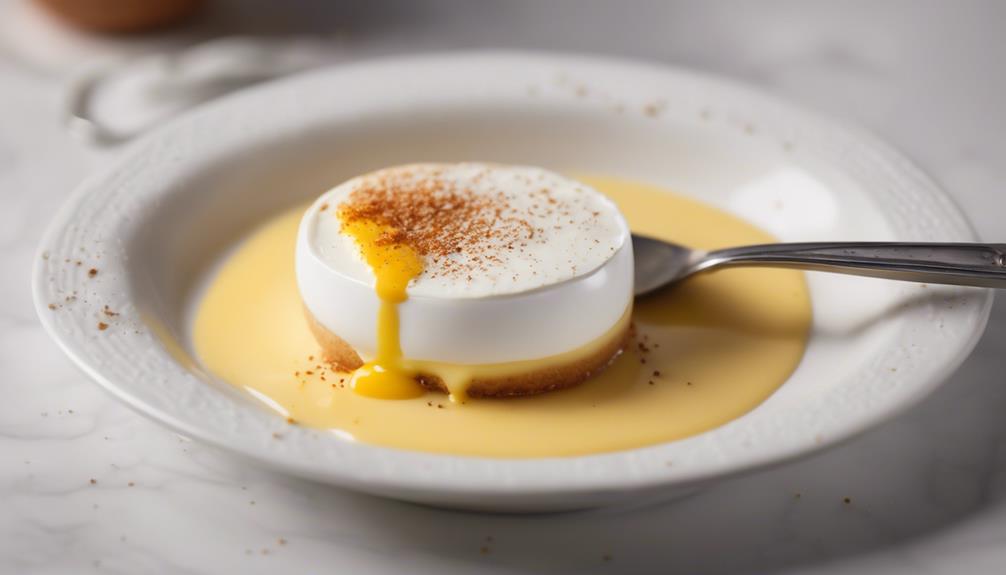
Understanding the fundamental elements that form the base of a delectable egg custard is important for achieving a perfect sous vide result. When preparing your sous vide egg custard, pay close attention to the key components that contribute to its flavor, texture, and overall appeal:
- Eggs: Selecting quality eggs is essential as they're the main ingredient in custard. Fresh, free-range eggs with bright yolks will give your custard a rich and creamy texture.
- Dairy: The type of dairy used, such as whole milk, heavy cream, or a combination of both, greatly impacts the custard's creaminess and richness. Opt for high-fat dairy for a luscious finish.
- Sweeteners: Balancing the sweetness is important. Whether using sugar, honey, or alternative sweeteners, make sure they're incorporated evenly to enhance the custard's flavor without overpowering it.
Custard Creations
Explore the world of custard creations with a creamy custard concoction that promises a decadent texture and rich flavor profile.
Immerse yourself in a velvety vanilla variation that adds a classic twist to this timeless dessert, offering a smooth and aromatic experience.
Indulge in the luxurious taste of caramelized sugar custard, where sweetness meets depth in a harmonious blend that delights the palate.
Creamy Custard Concoction
Crafting a velvety custard requires precise temperature control and a delicate balance of ingredients to achieve a smooth and luscious texture. When creating your own creamy custard concoction, keep in mind the following essential steps:
- Temperature Precision: Maintain a consistent temperature throughout the cooking process to guarantee the custard sets perfectly without curdling or becoming too runny.
- Ingredient Harmony: Combine eggs, sugar, cream, and flavorings in just the right proportions to achieve that silky smooth texture that melts in your mouth.
- Cooking Technique: Utilize gentle heat and gradual cooking to allow the custard to thicken slowly, developing its rich and creamy consistency.
Velvety Vanilla Variation
To achieve a velvety vanilla variation in custard creations, precise measurements of vanilla extract and a slow infusion process are essential for enhancing the smoothness and depth of flavor. Here are three key steps to help you create this delightful variation:
- Flavorful Infusions: Allow the vanilla extract to infuse slowly into the custard mixture, ensuring a rich and aromatic taste profile.
- Creamy Texture: Incorporate the vanilla extract in a way that adds to the creaminess of the custard, providing a luxurious mouthfeel.
- Versatile Dessert, Delicious Results: Embracing the velvety vanilla variation opens up a world of possibilities, offering a versatile dessert with consistently delicious results.
Caramelized Sugar Custard
For a decadent twist on traditional custard, infuse your creation with the rich flavors of caramelized sugar to elevate the sweetness and depth of your dessert.
When incorporating caramelized sugar techniques into your custard, consider the following:
- Temperature Control: Achieve the perfect caramelization by monitoring the temperature carefully to prevent burning and guarantee the sugar melts evenly.
- Flavor Balance: Experiment with different levels of caramelization to find the ideal balance between sweetness and depth of flavor in your custard.
- Texture Enhancement: Utilize caramelized sugar to add a delightful crunch or a subtle chewiness to your custard, creating a unique sensory experience for your guests.
Custard Consistency Techniques
When aiming to achieve the perfect custard consistency, consider thickening with starch for a stable texture.
Incorporating air bubbles during mixing can contribute to a lighter, smoother custard.
Additionally, balancing the sugar content is essential for both sweetness and structure.
Thickening With Starch
Frequently, starch is employed in sous vide egg custard recipes to achieve the desired consistency without relying on traditional thickeners.
Starch alternatives such as cornstarch or tapioca starch are commonly used to thicken custards, offering a velvety texture while enhancing flavor profiles.
When incorporating starch, it's important to mix it with a cold liquid before adding it to the custard base to prevent clumping. This technique guarantees a smooth and uniform thickening process.
Additionally, thickening techniques involving starch should be carefully monitored during the cooking process to avoid over-thickening, which can result in a gummy texture.
Incorporating Air Bubbles
To enhance the consistency of your sous vide egg custard, consider incorporating air bubbles as a technique for achieving a lighter texture. The whipping technique plays an essential role in incorporating air and altering the custard's overall texture.
By aerating the eggs effectively, you enhance the fluffiness of the custard, creating a smoother and more delicate mouthfeel. When whisking the eggs, guarantee a vigorous yet controlled motion to introduce air into the mixture gradually. This process helps to create a structure within the custard that contributes to its lightness.
Properly aerated eggs will result in a custard that isn't only creamy but also airy, providing a delightful contrast in texture that elevates the overall experience of this sweet protein treat.
Balancing Sugar Content
Achieving the perfect balance of sugar content in your sous vide egg custard is crucial for maintaining the desired consistency and texture. To guarantee sweetness balance and enhance the custard's nutritional benefits, consider using sugar alternatives and practicing portion control. Here is a table outlining some sugar alternatives and their benefits:
| Sugar Alternatives | Sweetness Level | Nutritional Benefits |
|---|---|---|
| Stevia | Very sweet | Low-calorie |
| Monk Fruit | Sweet | Antioxidants |
| Erythritol | Similar to sugar | Doesn't spike blood sugar |
| Xylitol | Similar to sugar | Helps fight cavities |
Final Thoughts
In conclusion, the Sous Vide Egg Custard offers a delectable balance of sweetness and protein, making it a versatile treat for any occasion. This protein-rich dessert not only satisfies your sweet indulgence but also provides a significant amount of protein, making it a unique and nutritious option for those looking to fulfill their cravings while maintaining a protein-packed diet. The precision of the sous vide cooking method guarantees a smooth and creamy texture that complements the rich flavor profile of the custard.
When serving others, the Sous Vide Egg Custard can be an elegant addition to your menu, offering a sophisticated yet comforting dessert option. The delicate balance of sweetness in this custard is perfect for those who enjoy a dessert that isn't overly sugary but still indulgent enough to satisfy a sweet tooth. With its creamy texture and subtle sweetness, this dessert is bound to impress your guests and leave them craving more of this delightful treat.
Frequently Asked Questions
Can Egg Custard Be Made Without a Sous Vide Machine?
Yes, you can make egg custard without a sous vide machine. Using a baking method or stovetop method, you can achieve a creamy custard. These methods require careful temperature control and monitoring to guarantee a perfect result.
Is It Possible to Use Alternative Sweeteners in Custard Recipes?
You can try sugar substitutes like stevia or erythritol in custard for a low-carb twist. Taste comparison shows slight differences, but they still provide sweetness. Baking alternatives like almond flour can also offer low-carb options for custard recipes.
How Can I Adjust Custard Consistency for Personal Preference?
To adjust custard consistency to your liking, experiment with cooking times and temperatures. Increase for firmer custard or decrease for a softer texture. Adjust sweeteners, use different milk, or vary egg ratios for flavor preferences.
What Are Some Unique Flavor Combinations for Custard Creations?
When thinking about unique custard flavors, consider fruit-infused custards for a revitalizing twist. For a savory touch, try pairing custards with ingredients like truffle oil or smoked salmon. Experimenting with unexpected combinations can elevate your custard creations.
Can Custard Be Stored for Later Consumption and Reheated?
When storing custard, refrigerate promptly for best freshness. Its shelf life is typically 3-4 days. Reheat gently in the microwave for quick enjoyment or use the oven for a more controlled and even heat distribution.
Conclusion
To sum up, sous vide egg custard offers a delicate balance of sweetness and protein, making it a versatile treat for any time of day.
By understanding the key components and utilizing proper consistency techniques, you can create a custard that's rich, creamy, and satisfying.
Experiment with different flavors and textures to elevate this classic dessert to new heights. Enjoy the journey of discovering the endless possibilities of sous vide egg custard.
